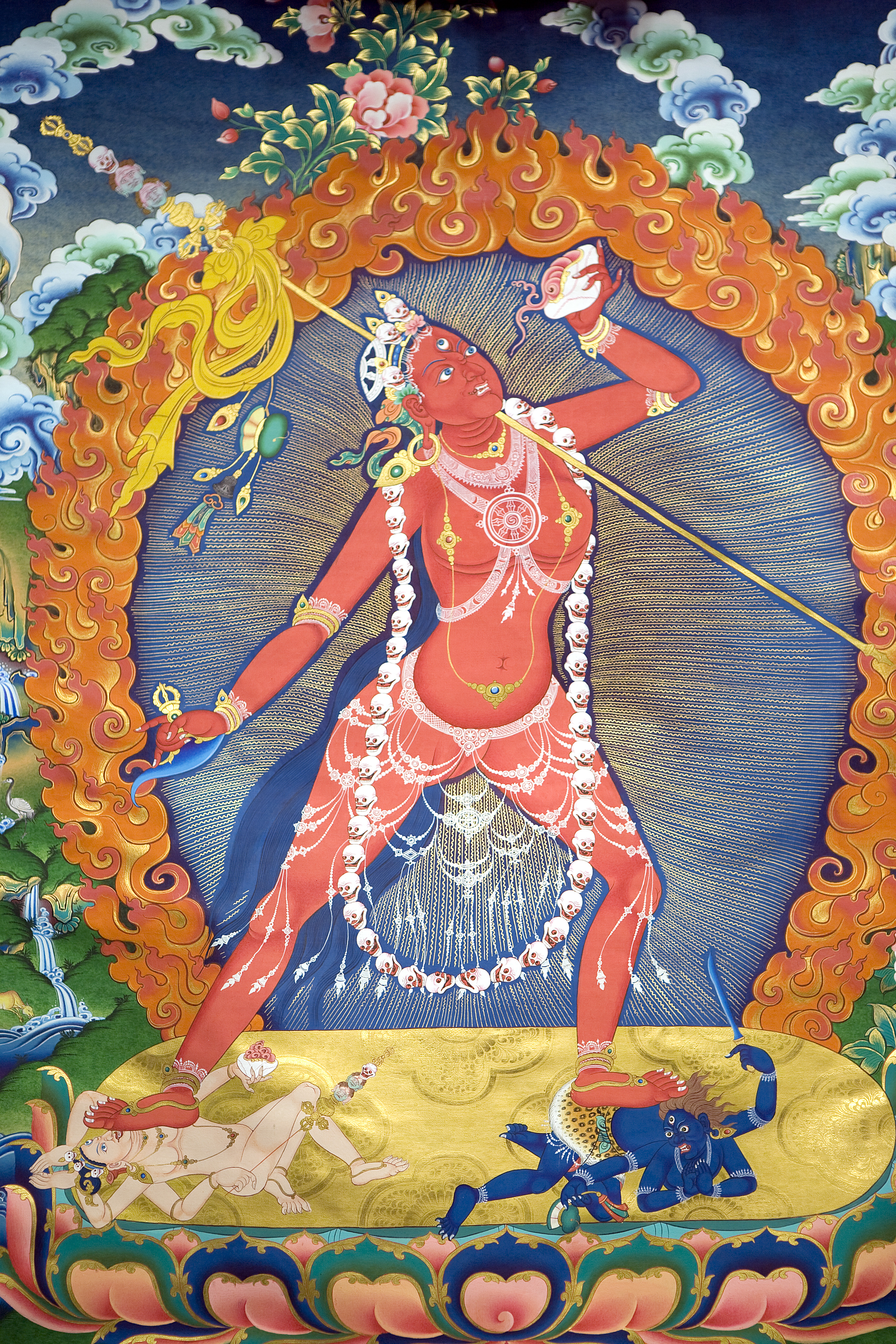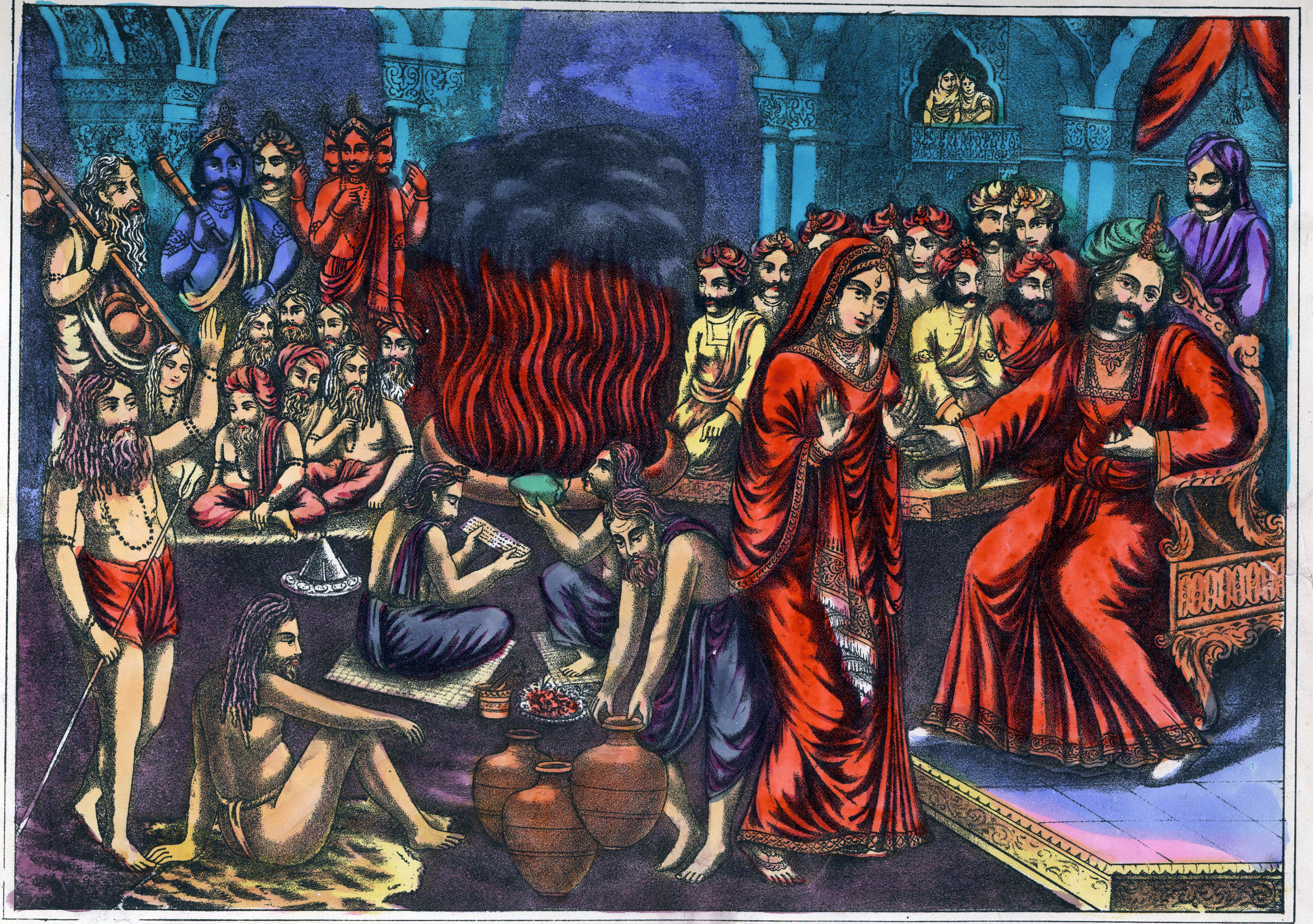|
Guhyeshwari Temple
Guhyeshwari Temple ( ne, ý§óý•Åý§πý•çý§Øý•áý§∂ý•çý§µý§∞ý•Ä ý§Æý§®ý•çý§¶ý§øý§∞), also spelled ''Guheswari'' or ''Guhjeshwari'', is one of the revered holy temples in Kathmandu, Nepal. This temple is dedicated to Guhyeshwari or Adi Shakti. The temple is also a Shakti Peetha and is about 1 km east of Pashupatinath Temple and is located on the southern bank of the Bagmati River. It is said that this temple is the Shakti chair of Pashupatinath Temple. It is an important pilgrimage destination for Hindus, especially for Tantric worshipers. King Pratap Malla renovated this temple in the 17th century. The goddess is also called Guhyekali. The temple's name originates from the Sanskrit words ''Guhya'' (secret, hidden, or cave) and ''Ishwari'' (goddess). Literally, the name "Guhyeshwari" stands for the goddess of the cave (ý§óý•Åý§´ý§æý§ïý•ã ý§àý§∂ý•çý§µý§∞ý•Ä) and the origin of the name aligns with the Hindu legend of Sati, her self-immolation when She turns into Adishakti, the Goddess ... [...More Info...] [...Related Items...] OR: [Wikipedia] [Google] [Baidu] |
Nepal
Nepal (; ne, ý§®ý•áý§™ý§æý§≤ ), formerly the Federal Democratic Republic of Nepal ( ne, ý§∏ý§ôý•çý§òý•Äý§Ø ý§≤ý•ãý§ïý§§ý§æý§®ý•çý§§ý•çý§∞ý§øý§ï ý§óý§£ý§§ý§®ý•çý§§ý•çý§∞ ý§®ý•áý§™ý§æý§≤ ), is a landlocked country in South Asia. It is mainly situated in the Himalayas, but also includes parts of the Indo-Gangetic Plain, bordering the Tibet Autonomous Region of China to the north, and India in the south, east, and west, while it is narrowly separated from Bangladesh by the Siliguri Corridor, and from Bhutan by the Indian state of Sikkim. Nepal has a diverse geography, including fertile plains, subalpine forested hills, and eight of the world's ten tallest mountains, including Mount Everest, the highest point on Earth. Nepal is a multi-ethnic, multi-lingual, multi-religious and multi-cultural state, with Nepali as the official language. Kathmandu is the nation's capital and the largest city. The name "Nepal" is first recorded in texts from the Vedic period of the India ... [...More Info...] [...Related Items...] OR: [Wikipedia] [Google] [Baidu] |
Dakshayani
Sati (, sa, ý§∏ý§§ý•Ä, , ), also known as Dakshayani (Sanskrit: ý§¶ý§æý§ïý•çý§∑ý§æý§Øý§£ý•Ä, IAST: ''DƒÅk·π£ƒÅya·πჴ'', lit. 'daughter of Daksha'), is the Hindu goddess of marital felicity and longevity, and is worshipped as an aspect of the mother goddess Shakti. She is generally considered the first wife of Shiva, the other being Parvati, who was Sati's reincarnation after her death. The earliest mentions of Sati are found in the time of the Ramayana and the Mahabharata, but details of her story appear in the Puranas. Legends describe Sati as the favourite child of Daksha, who marries Shiva against her father's wishes. After Daksha humiliates her and her husband, Sati kills herself in the yajna (Fire-Sacrifice) to protest against him, and uphold the honour of her husband. In Hinduism, both Sati and Parvati, successively play the role of bringing Shiva away from ascetic isolation into creative participation with the world. Sati's story plays an important part in shaping the ... [...More Info...] [...Related Items...] OR: [Wikipedia] [Google] [Baidu] |
Parvati Temples
Parvati ( sa, ý§™ý§æý§∞ý•çý§µý§§ý•Ä, ), Uma ( sa, ý§âý§Æý§æ, ) or Gauri ( sa, ý§óý•åý§∞ý•Ä, ) is the Hindu goddess of power, energy, nourishment, harmony, love, beauty, devotion, and motherhood. She is a physical representation of Mahadevi in her complete form. She is also revered in her appearances as Durga and Kali.Suresh Chandra (1998), Encyclopedia of Hindu Gods and Goddesses, , pp 245‚Äì246 She is one of the central deities of the goddess-oriented sect called Shaktism, and the chief goddess in Shaivism. Along with Lakshmi and Saraswati, she forms the Tridevi. Parvati is the wife of the Hindu god Shiva. She is the reincarnation of Sati, the first wife of Shiva who immolated herself during a yajna (fire-sacrifice).Edward Balfour, , The Encyclopaedia of India and of Eastern and Southern Asia, pp 153 Parvati is the daughter of the mountain-king Himavan and queen Mena.H.V. Dehejia, Parvati: Goddess of Love, Mapin, , pp 11 Parvati is the mother of the Hindu deities Ganesha and ... [...More Info...] [...Related Items...] OR: [Wikipedia] [Google] [Baidu] |
Hindu Temples In Kathmandu District
Hindus (; ) are people who religiously adhere to Hinduism.Jeffery D. Long (2007), A Vision for Hinduism, IB Tauris, , pages 35‚Äì37 Historically, the term has also been used as a geographical, cultural, and later religious identifier for people living in the Indian subcontinent. The term ''"Hindu"'' traces back to Old Persian which derived these names from the Sanskrit name ''Sindhu'' (ý§∏ý§øý§®ý•çý§ßý•Å ), referring to the river Indus. The Greek cognates of the same terms are "''Indus''" (for the river) and "''India''" (for the land of the river). The term "''Hindu''" also implied a geographic, ethnic or cultural identifier for people living in the Indian subcontinent around or beyond the Sindhu (Indus) River. By the 16th century CE, the term began to refer to residents of the subcontinent who were not Turkic or Muslims. Hindoo is an archaic spelling variant, whose use today is considered derogatory. The historical development of Hindu self-identity within the local In ... [...More Info...] [...Related Items...] OR: [Wikipedia] [Google] [Baidu] |
Swayambhunath
Swayambhu (Devanagari: ý§∏ý•çý§µý§Øý§Æý•çý§≠ý•Ç ý§∏ý•çý§§ý•Çý§™; new, ý§∏ý•çý§µý§Øý§Çý§≠ý•Ç; sometimes Swayambu or Swoyambhu) is an ancient religious complex atop a hill in the Kathmandu Valley, west of Kathmandu city. The Tibetan name for the site means 'Sublime Trees' ( Wylie: ''Phags.pa Shing.kun''), for the many varieties of trees found on the hill. However, ''Shingkun'' may be of the local in Tamang Bhasa name for the complex, Swayambhu, meaning 'self-sprung'. For the Buddhist Newars, in whose mythological history and origin myth as well as day-to-day religious practice Swayambhunath occupies a central position, it is probably the most sacred among Buddhist pilgrimage sites. For Tibetans and followers of Tibetan Buddhism, it is second only to Boudha. Swayambhunath is the Hindu name. The complex consists of a stupa, a variety of shrines and temples, some dating back to the Licchavi period. A Tibetan monastery, museum and library are more recent additions. The stupa has Bud ... [...More Info...] [...Related Items...] OR: [Wikipedia] [Google] [Baidu] |
Vajrayogini
Vajrayoginƒ´ ( sa, italic=yes, Vajrayoginƒ´ ý§µý§úý•çý§∞ý§Øý•ãý§óý§øý§®ý•Ä; , Dorj√© Neljorma; mn, –û–≥—Ç–æ—Ä–≥—É–π–¥ –û–¥–æ–≥—á, –ù–∞—Ä—Ö–∞–∂–∏–¥, ) is a Tantric Buddhist female Buddha and a . The ''Vajrayogini'' cult dates back to the tenth and twelfth centuries. Vajrayoginƒ´'s essence is "great passion" (''maharaga''), a transcendent passion that is free of selfishness and illusion‚Äîshe intensely works for the well-being of others and for the destruction of ego clinging. She is seen as being ideally suited for people with strong passions, providing the way to transform those passions into enlightened virtues. She is an Anuttarayoga Tantra i·π£·π≠adevatƒÅ (meditation deity) and her practice includes methods for preventing ordinary death, intermediate state (bardo) and rebirth ( samsara) by transforming them into paths to enlightenment, and for transforming all mundane daily experiences into higher spiritual paths. Practices associated with her are Ch√∂d and the Six Yogas of ... [...More Info...] [...Related Items...] OR: [Wikipedia] [Google] [Baidu] |
Kalabhairava
Bhairava (Sanskrit: ý§≠ý•àý§∞ý§µ ) or Kala Bhairava is a Shaivite and VajrayƒÅna deity worshiped by Hindus and Buddhists. In Shaivism, he is a powerful manifestation, or avatar, of Shiva associated with annihilation. In Trika system ''Bhairava'' represents Supreme Reality, synonymous to Para Brahman.Christopher WalliTantra Illuminated/ref> Generally in Hinduism, Bhairava is also called Dandapani (" e who holds theDanda in ishand"), as he holds a rod or Danda to punish sinners, and Sva≈õva, meaning "whose vehicle is a dog". In Vajrayana Buddhism, he is considered a fierce emanation of boddhisatva Ma√±ju≈õrƒ´, and also called Heruka, Vajrabhairava, and Yamantaka. He is worshiped throughout India, Nepal and Sri Lanka as well as in Tibetan Buddhism. Etymology Bhairava originates from the word ''bhƒ´ru'', which means "fearsome". Bhairava means "terribly fearsome form". It is also known as one who destroys fear or one who is beyond fear. One interpretation is that he protect ... [...More Info...] [...Related Items...] OR: [Wikipedia] [Google] [Baidu] |
Āryāvarta
ƒÄryƒÅvarta (Sanskrit: ý§Üý§∞ý•çý§Øý§æý§µý§∞ý•çý§§, lit. "abode of the Aryans, Aryas",Aryavarta Monier Williams Sanskrit English Dictionary (1899) ) is a term for the Indian subcontinent along with some other parts in the ancient Hindu texts such as Dharmasastra, ''Dharmashastras'' and ''Sutras'', referring to the area of the Indian subcontinent settled by Indo-Aryan peoples, Indo-Aryan tribes and where Indo-Aryan religion and rituals predominated. The limits of ''ƒÄryƒÅvarta'' extended over time, as reflected in the various sources, as the influence of the Brahmanism, Brahmanical ideology spread eastwards in post-Vedic times. Geographical boundaries Ganges-Yamuna doab [...More Info...] [...Related Items...] OR: [Wikipedia] [Google] [Baidu] |
Shiva
Shiva (; sa, ý§∂ý§øý§µ, lit=The Auspicious One, ≈öiva ), also known as Mahadeva (; …ê…¶aÀêdÙeÀê ã…ê, or Hara, is one of the principal deities of Hinduism. He is the Supreme Being in Shaivism, one of the major traditions within Hinduism. Shiva is known as "The Destroyer" within the Trimurti, the Hindu trinity which also includes Brahma and Vishnu. In the Shaivite tradition, Shiva is the Supreme Lord who creates, protects and transforms the universe. In the goddess-oriented Shakta tradition, the Supreme Goddess ( Devi) is regarded as the energy and creative power (Shakti) and the equal complementary partner of Shiva. Shiva is one of the five equivalent deities in Panchayatana puja of the Smarta tradition of Hinduism. Shiva has many aspects, benevolent as well as fearsome. In benevolent aspects, he is depicted as an omniscient Yogi who lives an ascetic life on Mount Kailash as well as a householder with his wife Parvati and his three children, Ganesha, Kartikeya and A ... [...More Info...] [...Related Items...] OR: [Wikipedia] [Google] [Baidu] |
Sati (goddess)
Sati (, sa, ý§∏ý§§ý•Ä, , ), also known as Dakshayani (Sanskrit: ý§¶ý§æý§ïý•çý§∑ý§æý§Øý§£ý•Ä, IAST: ''DƒÅk·π£ƒÅya·πჴ'', lit. 'daughter of Daksha'), is the Hindu goddess of marital felicity and longevity, and is worshipped as an aspect of the mother goddess Shakti. She is generally considered the first wife of Shiva, the other being Parvati, who was Sati's reincarnation after her death. The earliest mentions of Sati are found in the time of the Ramayana and the Mahabharata, but details of her story appear in the Puranas. Legends describe Sati as the favourite child of Daksha, who marries Shiva against her father's wishes. After Daksha humiliates her and her husband, Sati kills herself in the yajna (Fire-Sacrifice) to protest against him, and uphold the honour of her husband. In Hinduism, both Sati and Parvati, successively play the role of bringing Shiva away from ascetic isolation into creative participation with the world. Sati's story plays an important part in shaping the ... [...More Info...] [...Related Items...] OR: [Wikipedia] [Google] [Baidu] |



.jpg)



.png)

